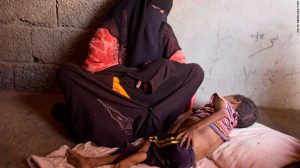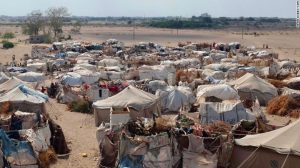Markets Full of Food and Children Starving to Death
YemenExtra
SH.A.
In Yemen, the markets have food, but children are starving to death.
By : Clarissa Ward
Ahmed Helmi ,a Yemeni child, spends most of his day lying on a thin sheet on a concrete floor in a dusty village in Yemen’s Lahij Province. It’s the coolest place in the house, and his mother, Soumaya, does what she can to make him comfortable.

Looking at his tiny, fragile body you would never guess that Ahmed is five years old. There is little more to him than parched, papery skin stretched across brittle bones and giant eyes — brown and unblinking — gazing up blankly.
Occasionally, Ahmed moves a hand, limply trying to swat at the flies that settle on his cracked lips. Soumaya explains that he only speaks when the pain overwhelms him.
“He tells me ‘my tummy hurts, my head hurts.’ He cries,” she says.
Ahmed is slowly starving to death. For four years he has been suffering from acute malnutrition, a vicious condition that took his brother’s life just two months ago. Soumaya says that she has taken him to various clinics but that no one has been able to help.
“He had diarrhea and infections always. And then he had malnutrition. I’ve taken him everywhere for treatment and they would tell us there’s nothing wrong with him. He’s fine, he’s normal … sometimes he would start getting better and then he would get diarrhea again and get sick again.”
What does famine look like? It’s a question one doesn’t often ask because the answer seems obvious.
Famine looks like dusty fields parched from drought, distended bellies and emaciated frames, a bad harvest with no crops. Famine looks like aid workers saving lives by handing out Plumpy’nut, packages of fortified nutritional paste. Famine looks like a page from the history books, the type of crisis that the world left behind in the 20th century.

But in Yemen, famine isn’t caused by a bad harvest or a drought — it’s caused by man.
In Yemen, aid workers are hunkered down in secure compounds in cities out of fear for their safety and boxes of Plumpy’nut rarely get to where they are most needed. In Yemen, children like Ahmed die because by the time they get treatment, the damage is irreversible.
The United Nations estimates that 8.4 million people in Yemen are just “a step away” from famine and that it will be the worst the world has seen in many decades.
Both sides are using food as a weapon of war, but the crisis is caused primarily by a brutal air, land and sea blockade imposed by a Saudi Arabia-led coalition.

What does come through is heavily taxed along the way, as it passes through territory controlled by different warring factions. Driving along, you pass markets flush with fresh fruit that no one can afford, while children starve a half mile down the road.
It’s a surreal and jarring image, one of many I carried home with me from Yemen. A doctor in the neo-natal ward of the main government hospital rinsing his hands with bottled water because there is no soap or working tap.
A three-year-old boy with a lung infection struggling to breathe because there is no ventilator to help him. His mother, face down on his hospital bed, too exhausted to weep over her only child. The resigned look on the doctor’s face when she tells me two days later that he didn’t make it.
There is little coverage of Yemen’s complex and confounding conflict, in no small part because Western journalists have been largely blocked from entering the country.
It is often called a silent war. But we found a country that is crying out for help as the world turns a deaf ear.

